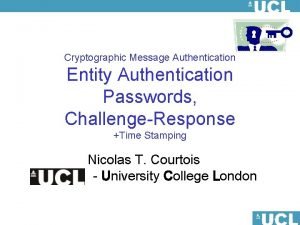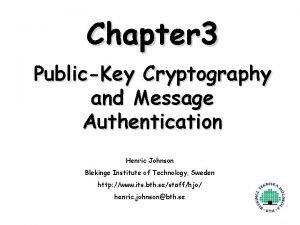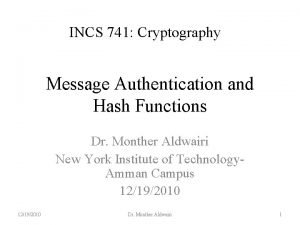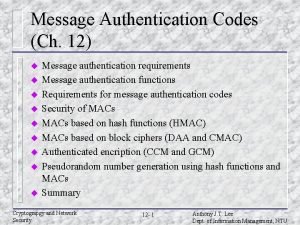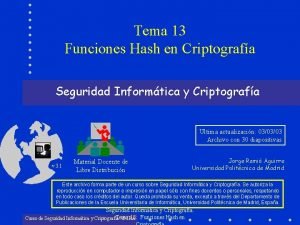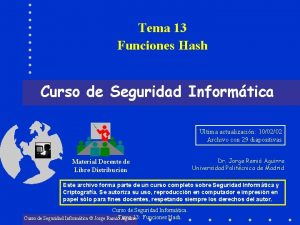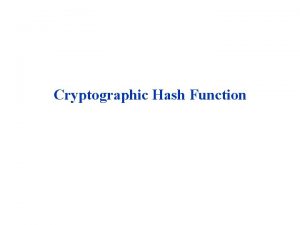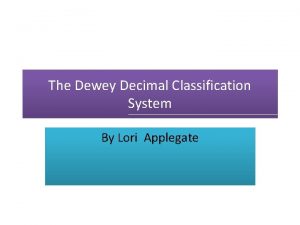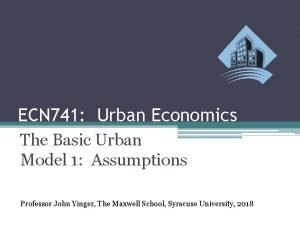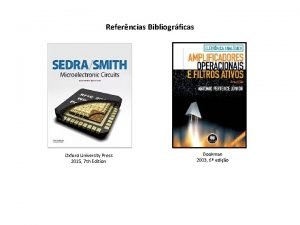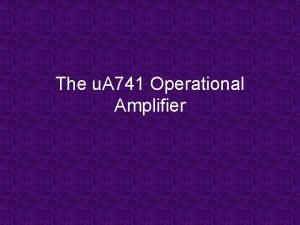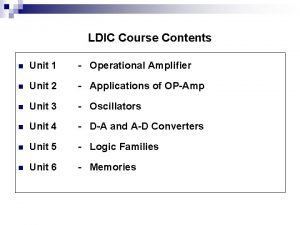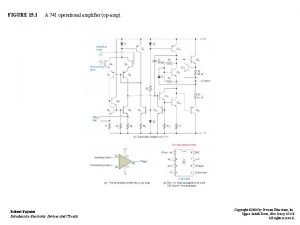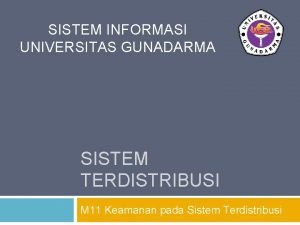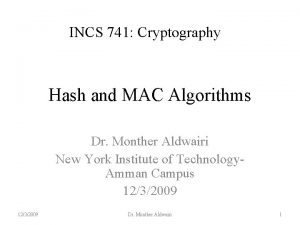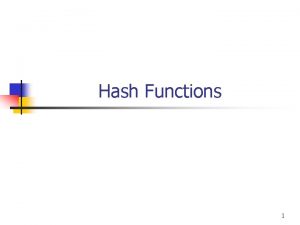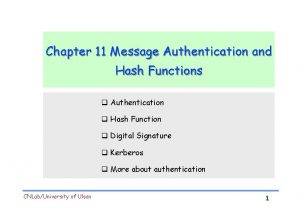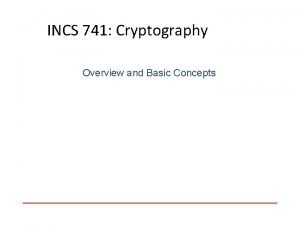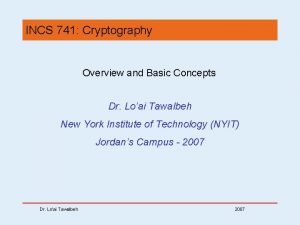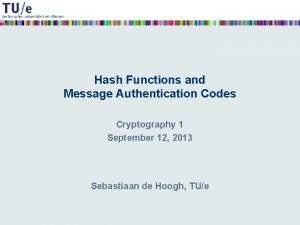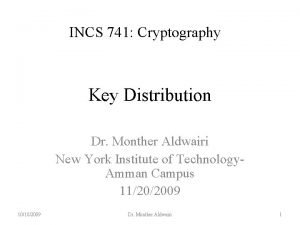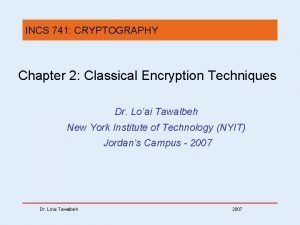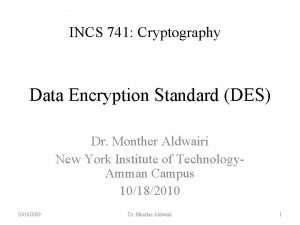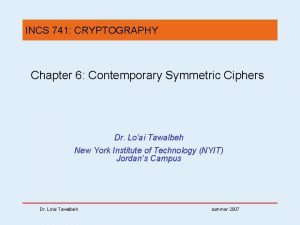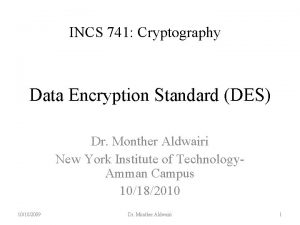INCS 741 Cryptography Message Authentication and Hash Functions




















- Slides: 20

INCS 741: Cryptography Message Authentication and Hash Functions Dr. Monther Aldwairi New York Institute of Technology. Amman Campus 12/19/2010 Dr. Monther Aldwairi 1

Authentication Requirements 1. 2. 3. 4. 5. 6. 7. 8. disclosure traffic analysis masquerade content modification sequence modification timing modification source repudiation destination repudiation

Message Authentication • message authentication is concerned with: – protecting the integrity of a message – validating identity of originator – non-repudiation of origin (dispute resolution) • will consider the security requirements • then three alternative functions used: – message encryption – message authentication code (MAC) – hash functions

Authentication Functions • message authentication/signature requires an authenticator: – a value to be used to authenticate a message. • functions that may produce an authenticator. 1. Message encryption: The ciphertext of the entire message serves as its authenticator 2. Message authentication code (MAC): A function of the message and a secret key that produces a fixed-length value 3. Hash function: A function that maps a message of any length into a fixed-length hash value 12/19/2010 Dr. Monther Aldwairi 4

Message Encryption • message encryption by itself also provides a measure of authentication • if symmetric encryption is used then: – receiver know sender must have created it – since only sender and receiver now key used – know content cannot of been altered – if message has suitable structure, redundancy or a checksum to detect any changes

Message Encryption • if public-key encryption is used: – encryption provides no confidence of sender – since anyone potentially knows public-key – however if • sender signs message using their private-key • then encrypts with recipients public key • have both secrecy and authentication – again need to recognize corrupted messages – but at cost of two public-key uses on message

12/19/2010 Dr. Monther Aldwairi 7

Message Authentication Code (MAC) • generated by an algorithm that creates a small fixed-sized block – depending on both message and some key – like encryption though need not be reversible • appended to message as a signature • receiver performs same computation on message and checks it matches the MAC • provides assurance that message is unaltered and comes from sender

MAC Properties • a MAC is a cryptographic checksum MAC = CK(M) – condenses a variable-length message M – using a secret key K – to a fixed-sized authenticator • is a many-to-one function – potentially many messages have same MAC – but finding these needs to be very difficult

Requirements for MACs • • taking into account the types of attacks need the MAC to satisfy the following: 1. knowing a message and MAC, is infeasible to find another message with same MAC 2. MACs should be uniformly distributed 3. MAC should depend equally on all bits of the message

Message Authentication Code

Message Authentication Codes • as shown the MAC provides authentication • can also use encryption for secrecy – generally use separate keys for each – can compute MAC either before or after encryption – is generally regarded as better done before • why use a MAC? – sometimes only authentication is needed – sometimes need authentication to persist longer than the encryption (eg. archival use) • note that a MAC is not a digital signature

Using Symmetric Ciphers for MACs • can use any block cipher chaining mode and use final block as a MAC • Data Authentication Algorithm (DAA) is a widely used MAC based on DES-CBC – using IV=0 and zero-pad of final block – encrypt message using DES in CBC mode – and send just the final block as the MAC • or the leftmost M bits (16≤M≤ 64) of final block • but final MAC is now too small for security

Data Authentication Algorithm

Hash Functions • condenses arbitrary message to fixed size h = H(M) • usually assume that the hash function is public and not keyed – MAC which is keyed • hash used to detect changes to message • can use in various ways with message • most often to create a digital signature

Hash Functions & Digital Signatures

Requirements for Hash Functions 1. 2. 3. 4. can be applied to any sized message M produces fixed-length output h is easy to compute h=H(M) for any message M given h is infeasible to find x s. t. H(x)=h • one-way property 5. given x is infeasible to find y s. t. H(y)=H(x) • weak collision resistance 6. is infeasible to find any x, y s. t. H(y)=H(x) • strong collision resistance

Simple Hash Functions • are several proposals for simple functions • based on XOR of message blocks • need a stronger cryptographic function (next chapter)

Block Ciphers as Hash Functions • can use block ciphers as hash functions – using H 0=0 and zero-pad of final block – compute: Hi = EMi [Hi-1] – and use final block as the hash value – similar to CBC but without a key • resulting hash is too small (64 -bit) – both due to direct birthday attack – and to “meet-in-the-middle” attack • other variants also susceptible to attack

Birthday Attacks • might think a 64 -bit hash is secure • but by Birthday Paradox is not • birthday attack works thus: m – opponent generates 2 /2 variations of a valid message all with essentially the same meaning m – opponent also generates 2 /2 variations of a desired fraudulent message – two sets of messages are compared to find pair with same hash (probability > 0. 5 by birthday paradox) – have user sign the valid message, then substitute the forgery which will have a valid signature • conclusion is that need to use larger MAC/hash
 Iff
Iff Public key cryptography and message authentication
Public key cryptography and message authentication Authentication functions in cryptography
Authentication functions in cryptography Message authentication functions
Message authentication functions Tema de hash hash
Tema de hash hash Tema de hash hash
Tema de hash hash Peer entity authentication and data origin authentication
Peer entity authentication and data origin authentication Authentication in cryptography and network security
Authentication in cryptography and network security Cryptographic hash functions
Cryptographic hash functions Message signature hash
Message signature hash Dewey decimal 741
Dewey decimal 741 Operacijsko pojačalo 741
Operacijsko pojačalo 741 741 urban dictionary
741 urban dictionary Circuito diferenciador con lm 741 amplifier
Circuito diferenciador con lm 741 amplifier Piedinatura 741
Piedinatura 741 Outline amplifier
Outline amplifier Difference between inverting and non inverting
Difference between inverting and non inverting A 741
A 741 Cipher-based message authentication code
Cipher-based message authentication code Sistem terdistribusi gunadarma
Sistem terdistribusi gunadarma A digital signature needs a private key system
A digital signature needs a private key system
